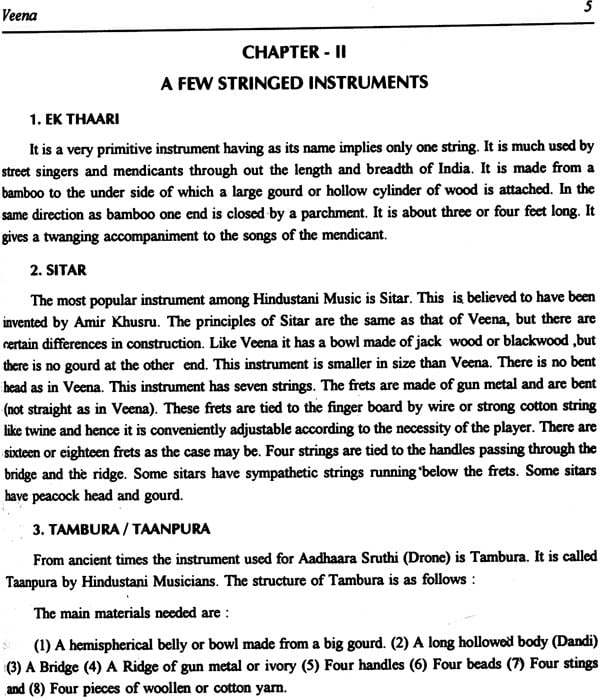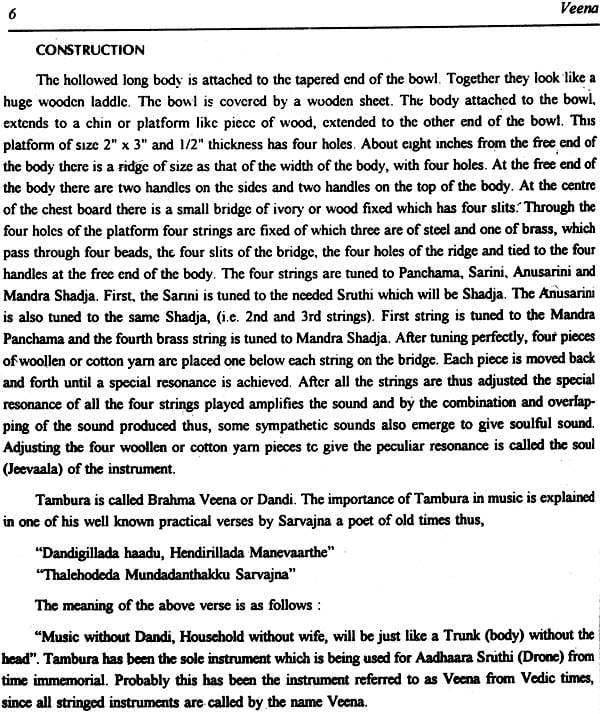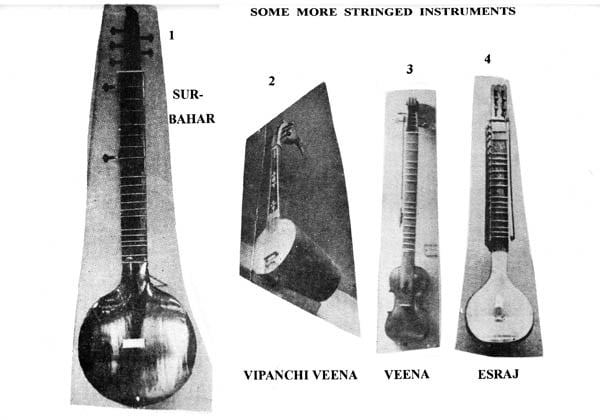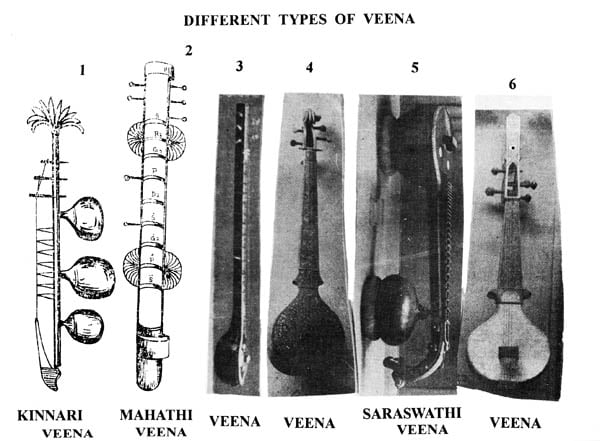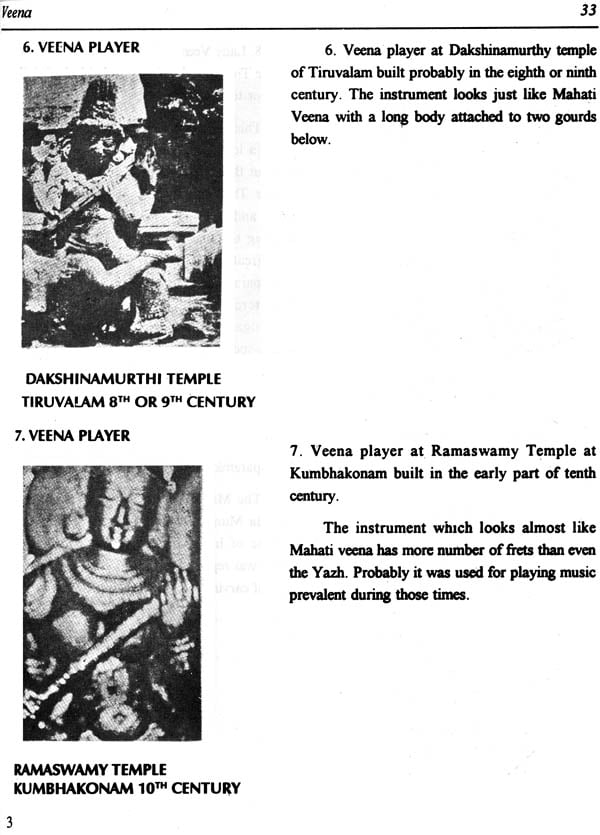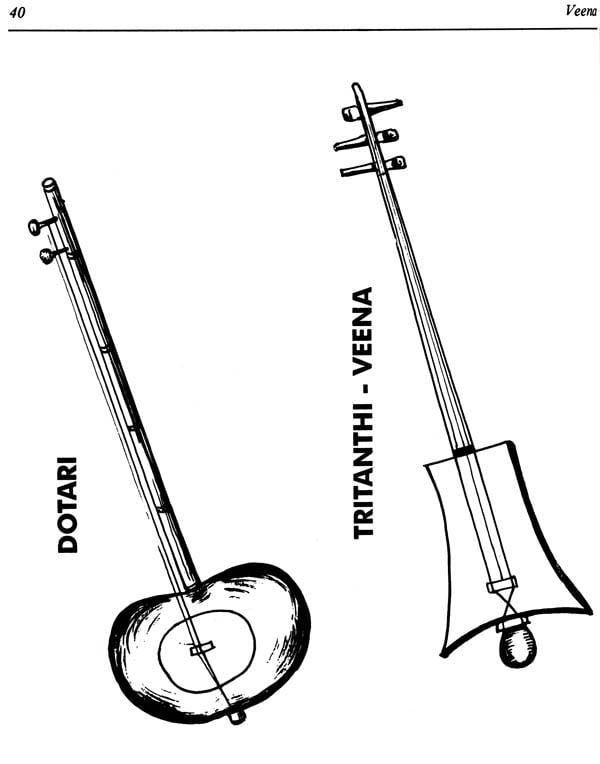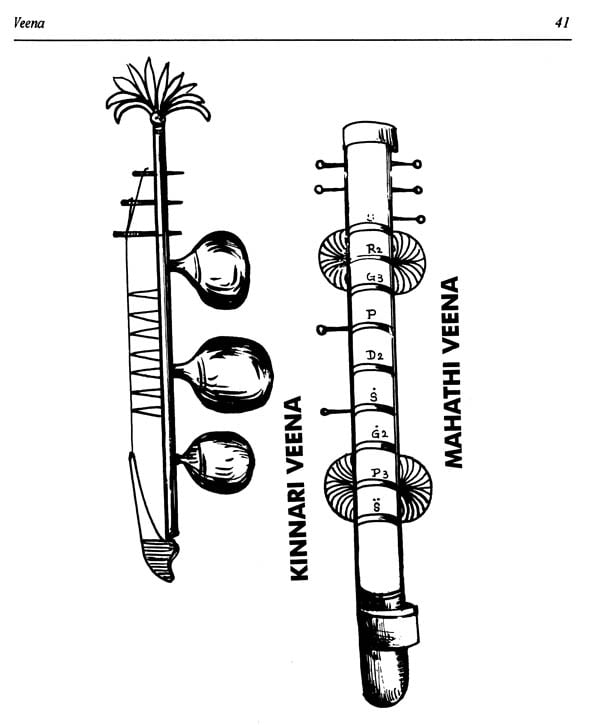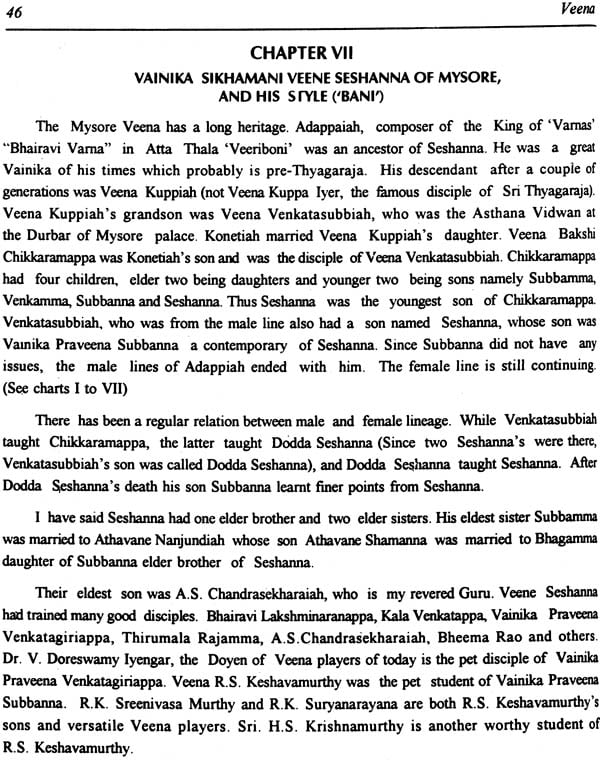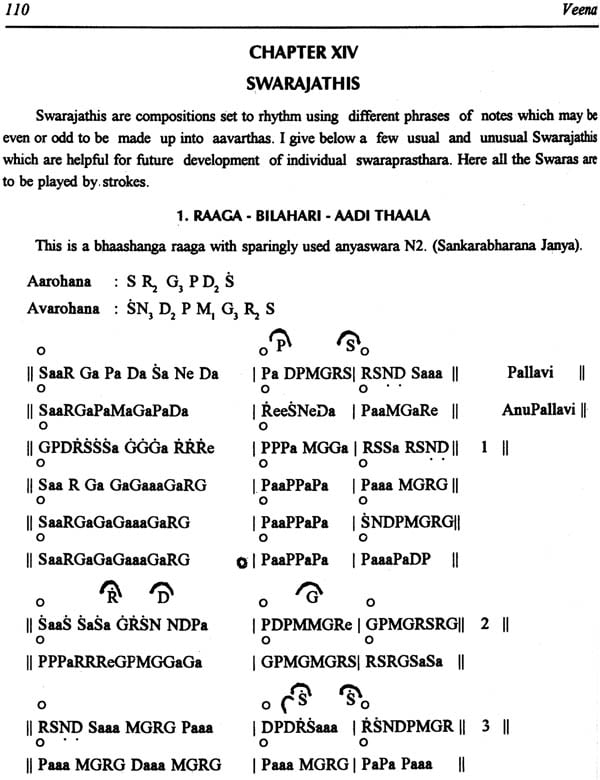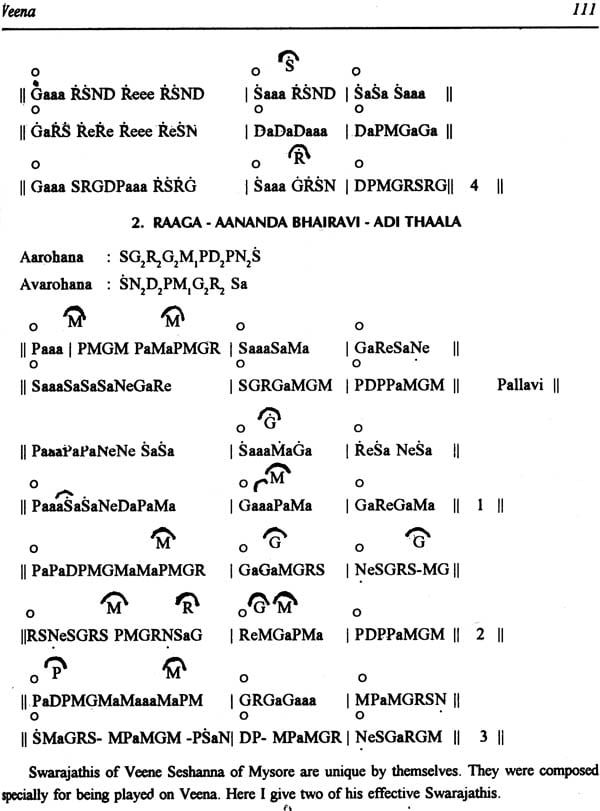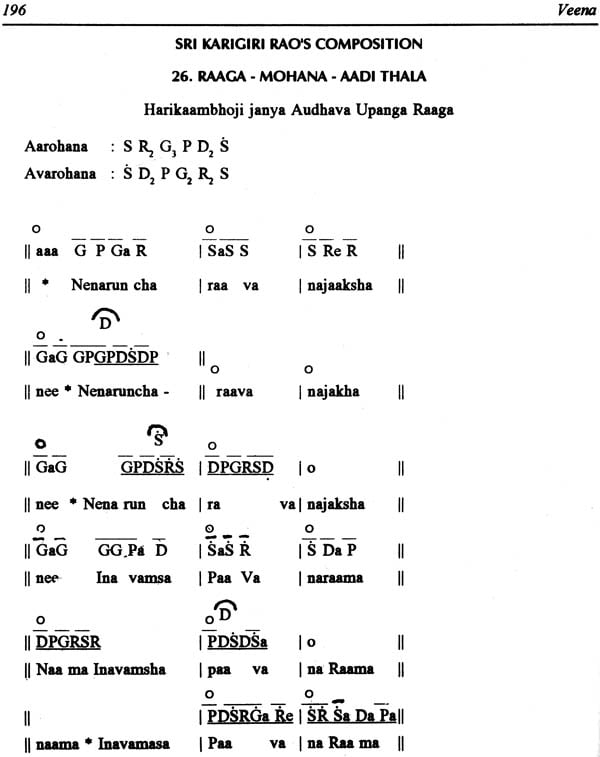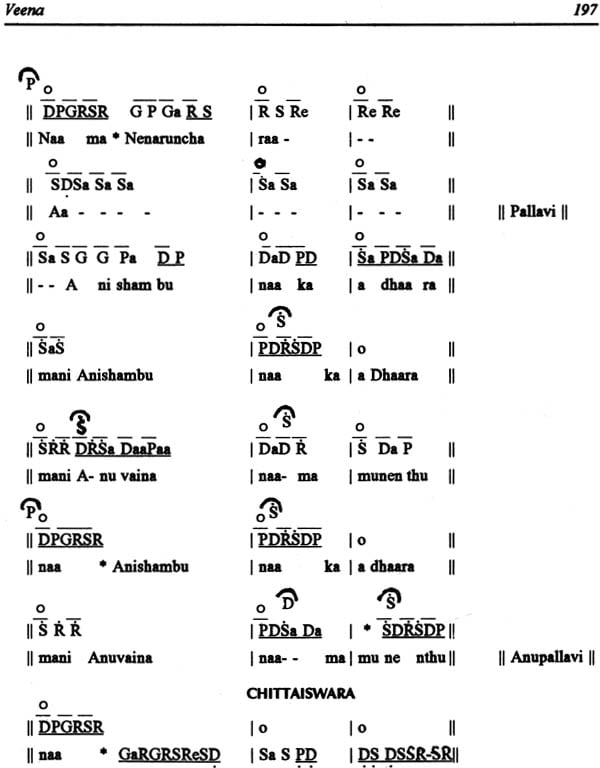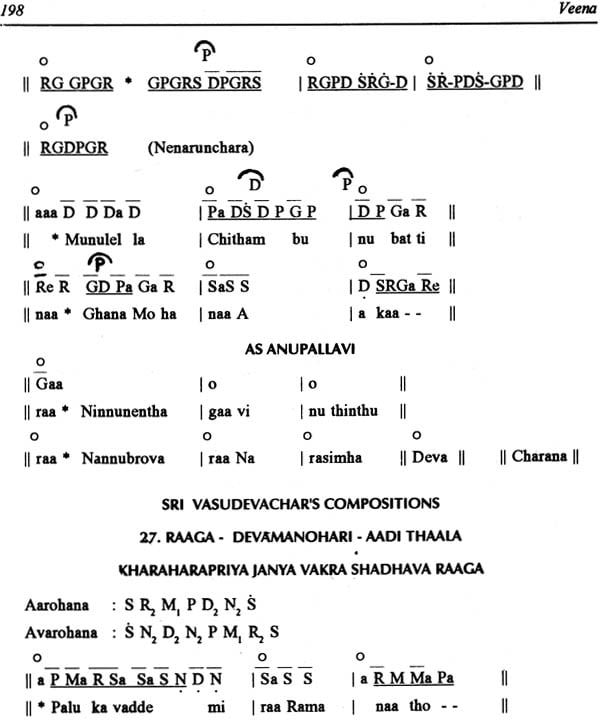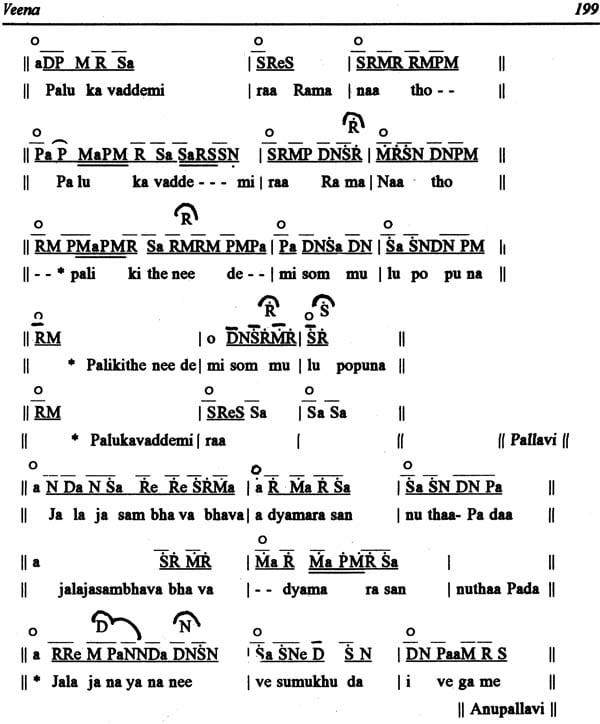
Veena: The Instrument Par-Excellence (With Notation)
Book Specification
| Item Code: | NAL333 |
| Author: | Vainika Vidwan and C.K. Shankara Narayana Rao |
| Publisher: | THE KARNATIC MUSIC BOOK CENTRE |
| Language: | English |
| Edition: | 2010 |
| Pages: | 257 (49 B/W Illustrations) |
| Cover: | Paperback |
| Other Details | 9.5 inch x 7.0 inch |
| Weight | 400 gm |
Book Description
Born on 18-11-1920 in Nanjangud to parents Sri.Krishnamurthy Rao and Smt. Puttamma had a craze for music even from childhood. After joining primary school at his sixth year at Chickaballapur having learnt the prayer songs ‘Swami Devane’ and ‘Sree Rameshane thava’ used to conduct the early prayer along with three more students in the morning and Mysore State anthem Kayau Sree Gowri after school. In the year 1934-35 learn’t vocal under Late. H. K. Seshagiri Rao. Harmonist upto Varna level. In the year 1935 when his brother’s wife Smt.Rajamani Nagaraja Rao came home brought her Veena with her. Naturally he was attracted towards it and knowing the technique of playing from sister-in-law played Lambodara Lakumikara on the first day itself, and started playing Varnas and Krithis looking into her music note book. But from July 1941 to 1950 learnt to play Veena Scientifically under the guidance of Guru Vidwan A.S. Chandrasekharaiah, grandson and direct disciple of Veena Seshanna of Mysore. Apart from accompanying Guru both in Mysore and Bangalore in 1949 Navarathri time, accompanied Guru before the Jagadguru of Sringeri Math. From then on accompanied Guru in various performances at Hyderabad, Madras, Poona, Bombay, Ahmedabad, Ajmeer and Delhi.
As per the guru’s wishes, he settled in Bombay from April 1950 to propagate Seshanna’s technique to the students. Then he started Tharangini Academy in 1970 and in November 1978 celebrated Sri.Seshanna’s 125th Birthday. In 1983 went to Sri Lanka and gave few performances.
He has been honoured by Chembur Karnataka Sangha, Mumbai Karnataka Sangha, Mysore Sangeetha Vidyalaya. Sriranjini Trust. of Dombivli:. Nadabrahma, Nadanjali and Snehasudha of Chembur, Mumbai Kannada Sangha and Mysore Association of Matunga, Bangalore Karnataka Gana Kala Parishat. Students felicitated him on his 60th birthday. During his 75th birthday the students collected funds and published his book on Veena in English and presented it to him. Karnataka Sangeeth Nruthya Academy made him write the same in Kannada and published the same as ‘VEENE SARVABHOUMA VADYA’ in 1999.
Veena is said to be the most ancient among the musical stringed instruments of India. It has undergone a long evolution before reaching the present state and condition. It is the most ideal instrument that could produce the subtle nuances of carnatic music.
Among the different schools of Veena that were existent in South India the Mysore school enjoyed a special, Mysore status. It was the great Maestro, Mysore Veena Sheshanna who added new special techniques of him own to the already existing sophisticated technique, and made the Mysore style of playing most widely acceptable.
It is in the fitness of things that Vainika Vidwan C.K. Shankaranarayana Rao, a disciple of Veena A.S. Chandra Shekharaiah, grandson of Veena Sheshanna, is bringing out a book on Veena, and its special techniques that are found only in the Mysore school of Veena. It is certainly a laudable venture.
In this book he has dealt with the evolution of Veena with the help of photographs of various temple sculptures. Another unique feature of this book is the explanation of the left hand and right hand techniques to be mastered by the students at the very early stage of learning. My own personal feeling is that these explanations would be worthwhile if the fingering techniques are presented through video recording. In the chapter on Tana otherwise known as Madhyanmakala, the author has explained the correct techniques to be adopted while rendering Tanas on veena.
The theoretical and practical aspects of the art of Veena playing that are dealt with in this book are complementary to each other and have made the book a comprehensive one.
Music has had an inevitable role since the inception of the Universe itself. Even during the days of caveman of the stone age, man used to express himself through music either by singing or by producing notes from inanimate objects like wood, stone etc.
From time immemorial wisemen have recognised the invisible hand of the Creator, who presides over the destiny of every living being and non-living thing. The sprouting of tender leaves in spring, the sight of the flora of different hues and colours, the humming of bees flying from flower to flower sucking the honey in them, the singing of birds, the cuckoo and nightingale, the dance of peacock opening out its multicoloured feathers in a natural geometric pattern of a near circle and the mimicking of parrots are all His Grace. Nature and music are inseparable. Hence, every intellectual wants to be one with nature. One of the ways to attain peace of mind is to pray by singing hymns and musical compositions of great masters. Needless to say that almost all our classical compositions are devotional in character. Saints Purandaradasa and Thyagaraja were such devotees that they had the Darshan of Lord Almighty in the form of Purandara Vithala and Sri Rama. This is true of Saint Ramadasa or Santa Tukaram, or Sant Tulsidas etc... the great saints of Bharat.
In our tradition or custom or culture, we are believers of ONE GOD, by whatever name we call Him. But we have a variety of names given to gods according to natural functions of the Universe; Agni for fire, Vayu for wind, Nataraja for dance, Surya for light, Brahma for birth or origin, Yama for death and so on. We have female deities Lakshmi the Goddess for wealth, Saraswathi the Goddess for learning music and arts. The celestial Veena is the symbol of Saraswathi who is holding it in an inclined posture, with the key-end at the top left shoulder and the striking end to the right bottom, the bowl resting on the right lap.
I had a thorough grinding on this instrument from the dedicated Veena Vidwan (Late) Shri. A.S. chandrasekhariah grandson and direct disciple of the great Veena Seshanna Mysore and with the same fervour I have imparted training to hundreds of students in the last five decades, which has enthused me to put on paper from time to time, all the genuine problems faced by them in mastering the Veena playing. While learning from a Guru, correct practices could be inculcated. With the passage of time, it may get blurred unless the student becomes a professional, in which case presentation of the techniques in the form of a book with correct notations and directions for the technique of the fingers to produce the correct note with necessary continuity and vibrations will be of great use. In order to make the book more useful, it has also been planned to produce a video to demonstrate visually for the readers and viewers. I am sure that this venture will prove a success with the support of my students and music practitioners.
In this book I have concentrated on the presentation of stringed instruments used in Indian music in general, and Veena in particular. First and foremost, I must pay my due respects to my Guru, Veena Vidwan A.S. Chandrasekhariah who has given me an insight into the technique of handling this celestial instrument, with no reservation whatsoever. Secondly, I am indebted to Veena Vidwan L. Raja Rao, a great exponent of Veena, a musicologist and composer, who had been a guiding force in my efforts to go deep into the theory of music.
Though the fingering techniques vary from one school to another, the techniques adopted by Veena Seshanna and other disciples of his are of a greater melodious type. This aspect as received by the Sishya Parampara of his has been uniquely stated in this book to enable the students to adopt with advantage.
I have incorporated some very important lessons and explained as far as possible how to practise them, particularly, the different fingering techniques to be followed. It will be helpful only to those who have personal training under an able master. If one can learn music from printed lessons, one could become a genius.
I have tried to express my feelings and oneness with the music world like a drop of water losing its identity in an ocean of knowledge. I state the above with great humility and with my limited vocabulary. It can only be experienced when the mind and the note struck by the fingers, coincide with each other.
I hope the students, teachers, music lovers and the critics will receive the book with openness it deserves and send their comments to me in order to improve its subsequent editions.
Before concluding, I will be failing in my duty if I do not acknowledge the encouragement and assistance given to me by my friends disciples and well wishers in various ways.
My deep sense of gratitude and thanks are due to the following well wishers.
Dr. V. Doreswamy Iyengar for blessing me with his foreword and also for permitting me to use his manuscript on ‘Bani’.
1. Vidwan Mysore V. Subramanya for providing me with photographs of Bakshi
2. Chikkaramappa, Veene Seshanna and Veena Subbanna together.
3. My close friend Sri. K.V.S. Sastry for having guided me in various ways in giving shape to my work.
4. My brother Sri. C.K. Nagaraja Rao a research oriented Kannada writer for helping me in getting photographs of Sculptures of stringed instruments from the office of the Archeological survery of India and for giving valuable suggestions in improvising the script apart from lending me some ancient book for reference.
5. My student, Sri. B.V. Prabhakara for helping me in dividing the script into proper chapters.
6. My student Smt. Manjari Gubbi and her husband for assisting me in procuring the photographs of stringed instruments from the Indian Museum, Calcutta.
7. Sri S. Ramakrishnan, who helped me in getting the correct period of construction of South Indian Temples through his friend Dr. John Paul.
8. Smt. and Sri Sukumar, my hosts during my stay in Madras for providing me the rare book “Vedaprakashike” (Veenarahasya) written by Yedathore Subbaraya Sharma in Kannada dealing with the comparision of Veena with Gayatri Mantra, Veda and Human body illustrated with suitable charts.
9. Smt. Gnanapurani and Dr. U. Madhvanath, my other hosts in Madras who have both assisted me in proof reading of the Laser typing and co-ordinating in so many ways during the publication.
10. Dr. Shanta Krishnamurthi and Sri. C. Krishnamurthi who have been solely responsible in forming the felicitation committee, preparing the appeal to the past and present students for collecting funds for the publication of the book.
11. Felicitation Committee of students headed by Sri N. Ramachandran who have taken the entire responsibility of the publication of the book.
12. Sri. S. Thiyagarajan of Maruthi Business Systems, for doing an excellent and patient job of transforming the Manuscript into perfect Laser Typesetting.
13. Sri. Lakshminarayanan of Sri Maruthi Graphics who has brought out the finished book efficiently.
14. I will be failing in my duty, if I do not mention Sri. T.S. Krishnamurthy, of Karnatic Music book Centre, Madras, who has all along co-ordinated the publication of the book. He has also under- taken the responsibility of the sale of the books through his Music Book Centre.
15. I should not forget my grandson chi. Sriharsha who first sketched the charts of old and new musical instruments in pencil, as per specifications given by me. Mr. Prakash Painter, a professional artist reproduced them in Indian Ink professionally. He also reproduced the three charts comparing the Veena with Gayatri Mantra, Veda and Human body, to whom I am indebted.
I dedicate this book to all great masters in the art of playing Veena, past and present.
| Foreword | vii | |
| Publisher's Note | viii | |
| Author's Preface | ix | |
| Bibliography | xiii | |
| Acknowledgments | xiv | |
| I. | Introduction | 1 |
| II. | A few stringed instruments | 5 |
| III. | Madhyama Sruthi | 15 |
| IV. | Seventy two melakarthas | 19 |
| V. | Evolution of Veena | 26 |
| VI. | Veena Rahasya | 43 |
| VII. | Vainika Sikhamani Seshanna of Mysore | 46 |
| VIII. | Playing of Veena (Fundamentals) Primary lessons (Exercises) Saralai - Datu - Janti | 56 |
| IX. | Thaalaprakarana - Alankaras | 68 |
| X. | Saadhaka Varasais - Fingering exercises | 82 |
| XI. | Madhyamakala (Thaanas) | 93 |
| XII. | Geethas | 97 |
| XIII. | Lakshana Geethas - Kedaragowla and Revathi | 105 |
| XIV. | Swarajathees - Bilahari - Anandabhairavai - Kharaharapriya, Junjhooti, Harikambhoji, Abhogi and Mohana | 110 |
| XV. | Varnas - Sankarabharana, Mohana, Kalyani, Nayaki, Bhairavi, Tarangini and Hamsanandi | 119 |
| XVI. | Keerthanas and Krithis |
| Raga | Composer | |||
| 1 | Saranu Benakane | Gowla | Purandaradasa | 134 |
| 2 | Saranembe Vani | Gambhiravani | Purandaradasa | 136 |
| 3 | Paalise ennasri | Sri | Purandaradasa | 138 |
| 4 | Smariso Sarvada | Rithigowla | Purandaradasa | 141 |
| 5 | Nadathanu | Chittaranjini | Thyagaraja | 143 |
| 6 | Meevalla guna | Kapi | Thyagaraja | 145 |
| 7 | Makelara | Ravichandrike | Thyagaraja | 148 |
| 8 | Samajavaragamana | Hindola | Thyagaraja | 150 |
| 9 | Naadasudha | Aarabhi | Thyagaraja | 153 |
| 10 | Sree Narada | Kaanada | Thyagaraja | 155 |
| 11 | Daasarathe Nee | Todi | Thyagaraja | 158 |
| 12 | Maarubalka | Sriranjini | Thyagaraja | 161 |
| 13 | Vaathapi Ganapathim | Hamsadhwani | Dixitar | 163 |
| 14 | Naagalingam | Sankaraabharana | Dixitar | 165 |
| 15 | Bhajarere Chitha | Kalyaani | Dixitar | 167 |
| 16 | Narasimha Aagacha | Mohana | Dixitar | 170 |
| 17 | Swaaminaatha | Naati | Dixitar | 173 |
| 18 | Sree Saraswathi | Aarabhi | Dixitar | 175 |
| 19 | Sree Subramanyaaya | Kambhoji | Dixitar | 177 |
| 20 | Devi Brova Samaya | Chintaamani | Shyama Sastry | 181 |
| 21 | Maravakave | Saama | Patnam Subramanya Iyer | 183 |
| 22 | Enthanerchina | Saveri | Patnam Subramanya Iyer | 185 |
| 23 | Ennagaanu | Kamavardhini | Ramadasa | 187 |
| 24 | Anudinamulu | Begada | Poochi Srinivasa Iyengar | 190 |
| 25 | Paramapaavana Raama | Poorvikalyani | Poochi Srinivasa Iyengar | 193 |
| 26 | Nenarunchara | Mohana | Karigiri Rao | 196 |
| 27 | Palukava demira | Devamanohari | Vasudevachar | 198 |
| 28 | Brochevarevarura | Kamach | Vasudevachar | 200 |
| 29 | Anupamaguna | Raagavardhini | Shankara Narayana Rao | 203 |
| 30 | Vanajaakshi Sri | Valaji | Shankara Narayana Rao | 205 |
| 31 | Namamyanisham | Madhyamavathi | Shankara Narayana Rao | 207 |
| 32 | Sowbhagyasura | Athana | C.K. Nagaraja Rao | 210 |
| 33 | Bhaavayami | Ragamalika | Swati Thirunal | 213 |
| 34 | Vallinaayaka | Shanmukhapriya | Muthiah Bhagavatar | 224 |
| 35 | Himagiri Thanaye | Udayaravichandrike | Muthiah Bhagavatar | 226 |
| 36 | Thillana | Behag | Veene Seshanna | 228 |
| Madhyama Sruthi Compositions | ||||
| 37 | Kadukurupe | Kapimadhyama | Purandaradasa | 230 |
| 38 | Thillana | Junjhooti | Veene Seshanna | 232 |
| 39 | Bruhimukundeti | Kuranji | Sadasiva Brahmendra | 235 |
| 40 | Saraswatheem | Tharangini | Shankara Narayana Rao | 236 |
| 41 | Mangala (Normal Sruthi) | Madhyamavathi | Purandaradasa | 238 |
